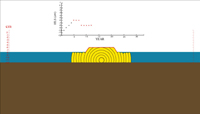|
|
To find evidence of past uplift and subsidence of the land, TO scientists investigate the growth pattern of local giant coral heads. Figure 1 shows a giant "Porites" coral head that was raised above sea level by the 2004 earthquake.

Figure 1 TO geologist John Galetzka measuring the height of exposed coral on Simeleu Island, which gives the amount of uplift caused by the Dec 2004 quake. At this location, the uplift is 46 cm (1.5 feet). Credit: Imam Suppihanto, John Galetzka, TO, republished with permission from Journal of Geophysical Research
Coral grows in annual rings, much like a tree. It prefers to be just below the sea surface. Thus if the land subsides, the coral will grow up toward the sea surface. But if instead the land rises, those portions of the coral that are exposed will die. Figure 2 shows how coral growth is affected by variations in the local water level as the land rises and subsides.

Figure 2 How Porites coral grows in relation to local water level.
a) Porites coral grows hemispherically outward by adding annual rings.
b) When the coral head reaches the sea surface, the portion exposed to air dies, while the submerged portion continues to grow outwards, increasing the coral's width.
c) If the land on which the coral sits subsides, any live portions of the submerged coral will grow upward, reaching toward the surface.
d) If an earthquake occurs and the land suddenly uplifts, exposed portions will die, while live submerged portions will grow wider by adding rings to the sides.
Credit: Danny Natawidjaja, Kerry Sieh, TO
Over hundreds of years, all this up and down motion affects the shape of the coral head.

Animation of Coral Growth in Response to Various Sea Level Changes. Black triangles indicate coral growing upward toward the sea surface; red circles indiate coral is at or above the sea surface and so can only grow outward. Credit: Danny Natawidjaja, TO
A thin slice of coral, removed with an underwater chain saw, is shown in Figure 3.

Figure 3 An actual cross section of a Porites coral head showing the annual bands. The shape of the cross section carries the history of the lands's uplift and subsidence. Credit: Danny Natawidjaja's Caltech thesis, 2002
From careful analysis of the shape of the coral head, TO scientists date both large, sudden vertical land shifts caused by earthquakes, as well as gradual vertical land shifts during interseismic periods. An example of such an analysis is shown in Figure 4.

Figure 4 Actual cross section of a Porites coral along with the resulting analysis of uplift and subsidence. The large yellow arrows in the lower panel point to small emergences due to three distant giant earthquakes occuring in 1797, 1833, and 1861 (magnitude 8.5 or greater), as well as a large emergence due to a local large earthquake occuring in 1935 (magnitude 7.7). Credit: Danny Natawidjaja's Caltech thesis, 2002
This type of analysis can be complicated by some factors such as changes in local sea level due to climate change, changes in the coral due to erosion, and uplift that raises the land by more than the coral's height. All these are taken into account in the final analysis.
Learn more:
- Introduction
- Why Earthquakes and Tsunamis Occur in the Sumatra Region
- What Happened During the 2004 Sumatra Earthquake
- Using Coral to Track the History of Earthquakes
- Rethinking the Causes of Giant Earthquakes
|

